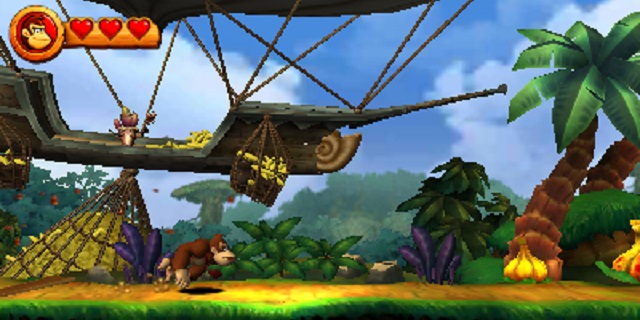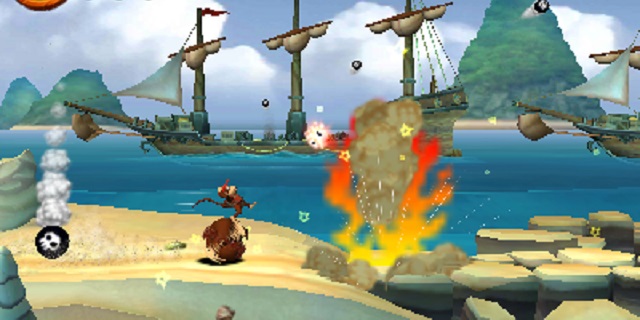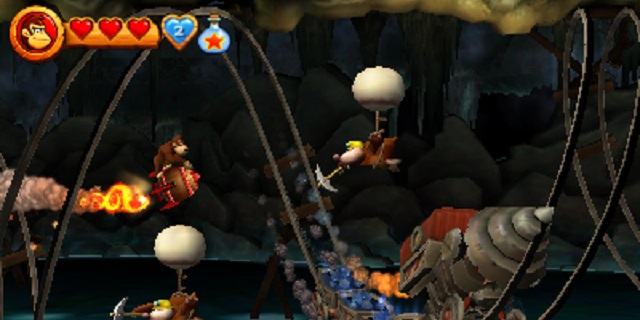
Playing a game you enjoyed a second time can be rough, potentially adding exposure to flaws you may have glossed over when the experience was exciting and new. I can safely say that, while it has its fair share of issues, Donkey Kong Country Returns 3D is as solid now as it was on the Wii.
First of all, the 3D is impressive. Play any given level, and you’ll believe that the game was built with 3D visuals in mind. The aesthetics of, well, Donkey Kong Country are distinctly layered, not only giving the game a deep sense of visual depth, but also having plenty of cool scenery popping out at you at the same time. It’s almost hard to focus at times with all the visual noise, especially if you’re playing on a standard 3DS. If anything, DKCR3D is a case study on why upgrading to an 3DS XL might be a good idea. The larger screen real estate helps accentuate the details as well as aid in comprehension. It’s still playable on the standard model, but there’s a lot to take in on such a small screen.

From a technical standpoint, the conversion to the portable system comes with a few drawbacks. There are occasional frame rate drops, and every now and then you can see that a few frames of animation had to be sacrificed (the rolls in particular look weird because of it). Otherwise, it seems pretty darn close to the original version. One big change: no longer using motion control to make things happen. It’s both good and bad. On one hand, pressing a button instead of shaking a remote takes out a lot of room for error, but on the other, it becomes clear that the original version was designed around waggling, and forcing it to abandon that exposes a fundamental problem with the controls that wasn’t quite clear before.
There were three motion-activated actions: rolling (the key move in the series), pounding the ground and blowing. Because of the bizarre addition of the blowing mechanic, the controls for rolling were mapped in such a way that you have to be moving before you can do it. Using the move action while you’re stationary results in pounding. Rolling is important, and it has been since the beginning of the series. Rolling allows you to make huge jumps, which can often be the difference between making it through a level and really being able to explore it. Something about physically waggling the remote made it work, more or less.

Taking that physical action required a bit more time than pressing a button, and the game seemed to compensate for that. It was different from what I was used to, but I got the hang of it and was able to master the game with relative ease. Now, for some reason there seems to be some dead air in the way the game wants you to time the button press, and the response time for the move has suffered as a result. Many times I’ve pressed the button only to have Donkey Kong calmly walk off the edge of a platform. I’m getting used to the new timing, but this is something that really shouldn’t be an issue.
Everything else that is Donkey Kong Country Returns is intact. It has tons of levels, even more now with an additional bonus world, all of which are well-designed. The music is fantastic, featuring arrangements of old tunes as well as plenty of great new stuff. There’s an odd lack of DKC world-building stuff, but all of the core elements are in place to make any longtime fan feel right at home without making newcomers feel lost. New Mode, for those that need the assistance, adds a few tools to help the player out that don’t go as far as to cheapen the experience.
Donkey Kong Country Returns 3D is still the same great game as before, with some minor hangups that aren’t pervasive enough to really hurt the experience. There isn’t a ton of new content, so I don’t know if casual fans have much of a reason to pick this up if they’ve already had their fill of the Wii version, but Donkey Kong fans and newcomers will find plenty to like about this release, especially if they have 3DS XLs.
Pros: A great console game with the novelty of portability, awesome 3D effects
Cons: Slight tech issues, rolling feels off, standard 3DS screen a little too small



















